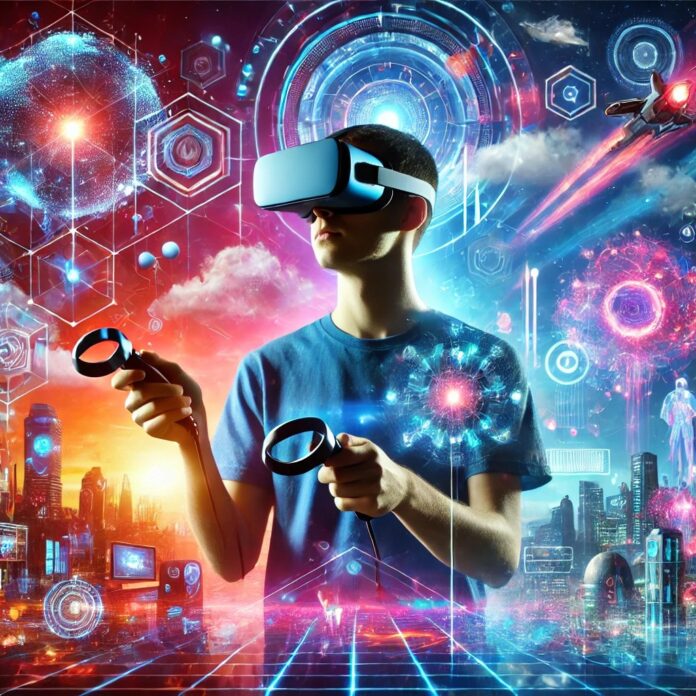Introduction to Virtual Reality
Virtual Reality (VR) has revolutionized the way we experience and interact with the digital world. By creating immersive environments, VR enables users to step into entirely new realms, enhancing entertainment, education, healthcare, and more. This article delves into the transformative power of Virtual Reality, its applications, and its potential future developments.
What is Virtual Reality?
Virtual Reality is a simulated experience that can be similar to or completely different from the real world. It involves the use of hardware and software to create realistic images, sounds, and other sensations that replicate a real environment or create an imaginary world. Users wear VR headsets, which typically include stereoscopic displays and sensors to track head movements, to experience these simulations.
Applications of Virtual Reality
Entertainment and Gaming
One of the most popular applications of VR is in the entertainment and gaming industry. VR games offer players an immersive experience, allowing them to feel as though they are truly inside the game. From action-packed adventures to serene exploration games, VR has expanded the possibilities for interactive entertainment.
Education and Training
Virtual Reality is also transforming education and training. VR provides a unique opportunity for immersive learning experiences. For example, medical students can practice surgeries in a virtual environment, and pilots can train using flight simulators. This hands-on approach enhances understanding and retention of complex subjects.
Healthcare and Therapy
In healthcare, VR is used for a variety of purposes, including pain management, physical therapy, and mental health treatment. VR can distract patients from pain, assist in rehabilitation exercises, and provide exposure therapy for individuals with phobias or PTSD. The ability to create controlled, immersive environments makes VR a valuable tool in the medical field.
The Technology Behind Virtual Reality
Hardware Components
The main hardware components of a VR system include the headset, controllers, and sensors. The headset, which houses the display screens and lenses, is crucial for creating an immersive experience. Controllers allow users to interact with the virtual environment, while sensors track movements to ensure accurate representation within the VR space.
Software Development
Creating VR experiences requires specialized software development. VR applications are built using game engines like Unity or Unreal Engine, which provide the tools necessary to create detailed and interactive virtual environments. Additionally, VR software must be optimized for performance to ensure smooth and responsive experiences.
Challenges and Limitations of Virtual Reality
Cost and Accessibility
One of the primary challenges of VR is its cost. High-quality VR headsets and equipment can be expensive, limiting accessibility for many consumers. While prices are gradually decreasing, affordability remains a barrier to widespread adoption.

Motion Sickness and Discomfort
Some users experience motion sickness or discomfort while using VR. This can be caused by a disconnect between the visual and vestibular systems, leading to symptoms such as nausea, dizziness, and headaches. Developers are continuously working to reduce these issues through improved hardware and software design.
Content Availability
The availability of engaging and high-quality VR content is another challenge. While there has been significant growth in VR content, especially in gaming and entertainment, other areas still require more development. Expanding the range of VR experiences will be crucial for its continued growth.
The Future of Virtual Reality
Advancements in Technology
The future of VR looks promising, with advancements in technology set to enhance its capabilities. Improvements in display resolution, field of view, and motion tracking will lead to more realistic and immersive experiences. Additionally, the development of haptic feedback and other sensory technologies will further enhance the sense of presence in virtual environments.
Integration with Other Technologies
Virtual Reality is also expected to integrate with other emerging technologies, such as Artificial Intelligence (AI) and Augmented Reality (AR). AI can enhance VR experiences by creating more realistic and responsive environments, while AR can blend virtual elements with the real world, offering new possibilities for interaction and immersion.
Conclusion
Virtual Reality is a transformative technology with the potential to revolutionize various industries. From gaming and entertainment to education and healthcare, VR offers immersive experiences that enhance our understanding and interaction with the digital world. While challenges remain, ongoing advancements in technology and content development promise a bright future for Virtual Reality. As VR continues to evolve, it will undoubtedly play an increasingly significant role in our daily lives, shaping the way we learn, work, and play.



